 |
||||
|
Animal InformationDoes that baby animal really need help?Each spring our rehabilitators are inundated with young animals who are in desperate need of help after being abandoned or orphaned. The sad fact is that many of those babies weren't orphaned or abandoned. By taking in a wild animal you could be depriving that baby his mother and a much better chance for survival. What to do and when to leave them alone.If you uncertain of what to do in any wildlife situation, please contact FOW and we will help guide you. If you have a problem with an animal making her home somewhere you don't appreciate, please contact us for important advice on how to best handle the situation and how to move the animal humanely. Following is background information on common native Michigan wildlife and what to look for when determining if that baby truly needs our help.
Additional Resourcehttp://wildlifehelp.info is a resource for Michigan rehabilitators that do not have the capabilities or funds to have a personal web site. It is very comprehensive and could answer any questions our site does not cover.
Baby Animals of all SpeciesPlease remember what the signs of a truly needy animal are before removing him, and then be sure to follow some simple rules:
Cottontail Rabbits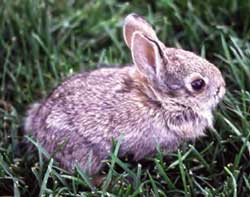 Cottontail rabbits, which are born March through October, are often found in the center of yards. The mothers plan it that way because she knows most predators usually don't go into wide open spaces, and her periphreal vision when sitting a ways from the nest allows her a clear view of anything approaching her babies. Mom rabbit only goes to her nest when she is feeding her babies, usually only twice a day, generally at dusk and dawn and then only for five minutes at a time. Because of this, most people think the mother has abandoned the nest when they find it and never see the mom around. But it's important to be absolutely sure that the babies are truly orphaned before bringing them to any rehabilitator as 90% of the babies will die when taken from their nest. The best way to check and see if the nest has been visited by mom is to mark the top of it with thin twigs in the mark of a tic-tac-toe pattern and check after 24 HOURS (but not at dusk or dawn when she may be hesitant to nurse if she sees you there). If the twigs have been moved, mom has been there. Cottontails are born furless with their eyes and ears closed. They are fully furred at one week of age. Their eyes open a few days later. In another week and a half they will wander away from the nest and be on their own. Because baby rabbits are only in the nest three weeks, it's not unusual to see a tiny one in your yard. If something other than mom has gotten into the nest (your dog for example) try and rebuild it and check to see if any of the babies have any injuries. If you have found a nest in your yard, accompany your dog outside if you know he's discovered it. Outdoor cats should wear a bell to alert wildlife, but it would be better for the wild animals and the cat to remain indoors. If you have to mow the lawn, put a laundry basket on top of the nest with a couple of bricks to hold it down until you're done. Remember, the best thing you can do to help the cottontails in your yard is to leave the nest alone. Mom will take better care of her babies than the best rehabber ever could. <back to top
Fawns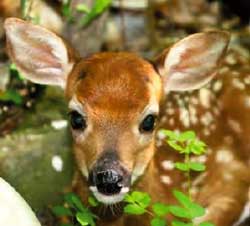
Female deer, known as Does, give birth to their fawns in late May/early June. The doe then deliberately leaves her fawns alone to protect her infants. For the first two weeks, newborns have no scent and cannot be found by predators, unlike mom, whose scent may attract a predator to her baby. The fawns have a wonderful camouflage - their natural spotted coloring - for their defense and it's normal for a fawn to "freeze" when approached. Even the best rehabbers have practically tripped over the fawn they've been told has been orphaned while looking for them in the woods. The doe, while well hidden, is still nearby watching her baby. She will come back a couple times a day to feed her fawns, but she nurses quickly and it's unlikely you would ever see her. It breaks our hearts to know how often a fawn is picked up by a well intentioned but ill-informed person and the doe is watching, helpless to what is happening to her baby. It's important that the fawns be left alone. The doe will move them when she knows they're ready. If they are in harms way, it is OK for you to move them a few yards away from danger but then leave them alone. The doe can easily find her babies. If you come across an infant fawn curled up like a cat sleeping, not crying, and no sign of a dead mother, you need to leave that baby alone. On the rare occasions a fawn is truly orphaned, these signs will be obvious:
Fox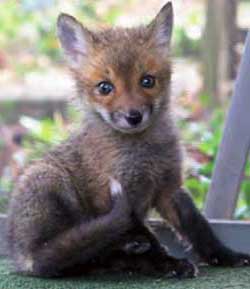
There are two species of fox in Michigan, the Red and the Gray. The Red prefer meadow areas and the Gray favor woods. As with most wildlife, the kits are born in early spring. The vixen (female fox) chooses a hollow log, an empty woodchuck hole or a roadside culvert for the nursery. This nest site provides her young protection from predators, especially coyotes. The male fox helps with the rearing by bringing the vixen food while she nurses their young and keeps the kits warm. Then later in the kits development both parents teach them how to forage for food. The foxes diet consists mainly of small rodents, moles and bugs. The benefits that foxes afford farmland, orchards and the general public is their consumption of these invasive pests. It is an absolute miss conception that fox eat cats, dogs or small children. They are very curious creatures but avoid contact with domestic animals and humans. When fox kits are first born, their eyes and ears are closed, they remain secluded in their den with their mother. As they develop, at about one month, they start venturing out to play, attacking twigs, leaves and their siblings, but never far from the protection of the den. If you do find an infant fox, please contact FOW for further instructions. <back to top
Opossums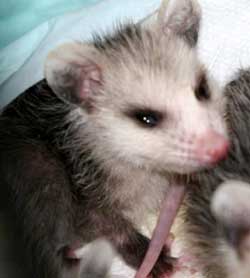
As North America's only marsupial, the opossum is unique and widely misunderstood. They are important to the environment by keeping areas clean. If you're a gardener, you'll enjoy having a possum in your yard as slugs are a favorite food of theirs. They are generally non aggressive, playing dead when confronted by predators. Sadly, though, many of these slow moving adults (with extremely poor eyesight) are killed on roads and by pet dogs and cats. Because a female carries her babies in her pouch, they are often found by passers-by when the pouch relaxes and they can easily crawl out. It's important to make sure that the mother is truly dead before taking her babies. Though rare, we have been brought babies taken from the pouch of a possum who was just playing possum! Sadly, when mom woke, she quickly ran away (startling those who were burying her) without her babies. It is safe to assume mom is truly dead if she is stiff and cold or with flies and maggots on her body. Because some babies choose to stay in the pouch while others crawl out and sit on her body, they are often left behind. When you are saving baby possums, check the inside of her pouch by just pulling it open like you would a shirt pocket, and look around and under her body. <back to top
Squirrels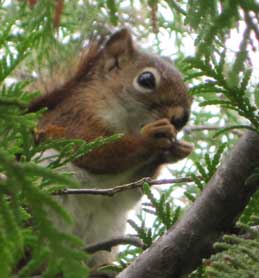
The most common varieties of squirrels native to Michigan are the larger orangebrown fox squirrel and the grey squirrel, which may also be seen with black fur. Both of these types of squirrels live in tree nests, and prefer nuts, seeds, and some vegetation. They generally have 3-4 babies per litter. Smaller red (pine) squirrels are also common in many neighborhoods and have 6-8 babies per litter. This variety of squirrel may attempt to nest in a car engine, dryer vent, or inside wall space. Call the squirrel help line for suggestions to encourage them to move out of the unwanted space. Please do not trap and remove adult squirrels unless you are absolutely positive there are no babies left behind! The mother does a much better job raising babies, and our volunteers get overwhelmed with young ones after high winds, thunderstorms, and other natural occurrences. Baby squirrels may be placed back with mother up to 72 hours after falling from a nest. If a leaf nest has blown down after a storm or other event, it may take 4-6 hours for the mother to locate a new nest site and build a new nest. Babies who seem lethargic and cold may recover some energy after being warmed to a normal body temperature of 103 degrees by providing a sock with uncooked rice in it heated in the microwave until it is warm to the touch. Do not place babies outside unattended for long periods of time due to predators such as cats, dogs or birds. While waiting for a mother squirrel to retrieve babies, place the babies in an open container with a towel to snuggle with, as close to the original nest site as possible. Watch from a house or car window so the mother feels safe to approach. If an adult squirrel approaches a baby and does not attempt to take it to the nest, it's probably an unrelated squirrel. If she does not return by dusk, bring the babies inside and call the FOW squirrel help line. The sure signs that a baby squirrel is in need of help are:
Raccoons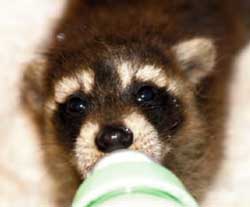
Baby raccoons are born between March and June and the average litter size is four infants. Often juvenile raccoons will be out exploring without their mother. Though mom is nocturnal, the little ones are not until they are about 11 months old. If you find a kit, or several huddling together and hiding, or coming up to you out of curiosity, please don't think they need help, and certainly don't feed them as this may attract predators who may harm them. They are beginning to explore their world while mother sleeps nearby. It may also be the time for mother to move to a new den, so some may just be waiting for her to come back as she can only carry one at a time. If the babies are removed, their mother will frantically search for them for a week to ten days. Other mother raccoons also adopt orphaned kits, so please, when possible, leave them be as no rehabber is as good as a mom. Signs that raccoons truly need help are if they are:
Please check with a wildlife rehabilitator before removing them as raccoons are very susceptible to feline distemper, a type of parvo, and leptospirosis. Roundworm is also a concern so it's important to wear gloves when handling even baby raccoons. <back to top
Turtles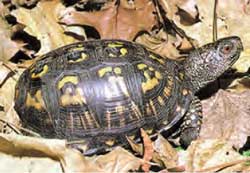
Spring and early summer is nesting season for turtles. The females tend to lay eggs during a drop in barometric pressure which usually precedes rain or a thunderstorm. They may dig several false nests before finally deciding on the perfect spot. Nesting can take anywhere between 12 and 24 hours. If you find a turtle on your property, assume she is nesting and keep children and pets away from the nesting site. She will find her way back to a water source after she is through laying her eggs. Turtles do not stay at the nesting site to incubate the eggs and, depending upon temperature, the eggs will hatch in 90 to 120 days. Turtles frequently cross roads during the breeding season. If you find a turtle on the road, move it to the side in the direction it was going. Although it may be tempting, do not remove a turtle from the wild to become a child's pet. It is illegal in Michigan to take turtles from their wild habitat. Observe them in their natural habitat. They can be a fascinating nature study for you and your children. <back to top
Woodchucks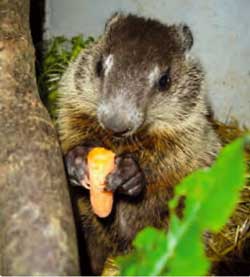
A woodchuck, or groundhog as they sometimes are called, is the largest member of the squirrel family. They have one litter a year averaging four babies and are born March through May. The babies are almost always hypothermic if they leave the den in search of their mom, so finding a baby out of the den is a sure sign that something has happened to the mother and the baby is truly in need of rehabilitation. Woodchucks are one of our few true hibernators in the winter so they must adapt slowly to the changing climates in the springtime. Because they are "edge eaters", they often get hit by cars while looking for and eating fresh new vegetation along the roadsides. They are diurnal animals (active during the day) and are often blamed for undermining buildings. Actually, they dig straight down several feet and then tunnel to make a den. <back to top |
|||
